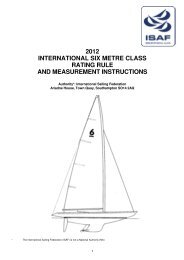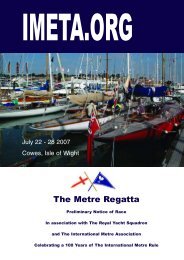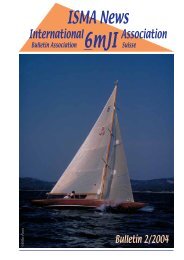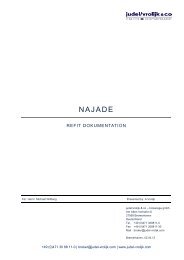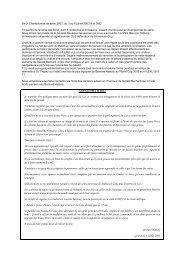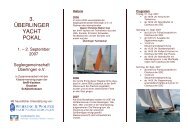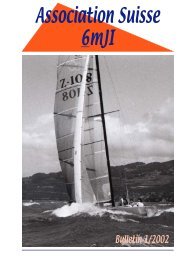CLASSIC SIX METRE NEWSLETTER
CLASSIC SIX METRE NEWSLETTER
CLASSIC SIX METRE NEWSLETTER
You also want an ePaper? Increase the reach of your titles
YUMPU automatically turns print PDFs into web optimized ePapers that Google loves.
The transverse loads from the shrouds at the mast can be met in two ways. Firstly, we want<br />
to try and stop the deck flexing upwards by running braces to the mast step. These are<br />
usually rigging wires, rods or plates set from the underside of the chain-plates at the sheer<br />
strake down to the mast step (the “diagonals” referred to in the photos). The angle of these<br />
wires is usually not really ideal; you’d like to pull straight down if you could, but the strength<br />
of the mast step often makes it the only option. As these wires are often at close to 45<br />
degrees, when tensioned they are then also trying to pull the sides of the deck together,<br />
making the local compression loads worse. So it is sensible to make sure the deck structure is<br />
adequate. The deck camber is working against you here, so reinforcement of deck beams is<br />
often coupled with a tie rod (see the varying view of Brian Pope on this point below).<br />
A vertical tie rod or bar is a pretty traditional item, but it is surprising how often they are misused<br />
or removed altogether. A tie rod should ideally be a fixed length and as close to the<br />
mast as possible, normally just aft. Its primary function is to resist the deck from moving<br />
upwards; “shrugging” (the terms is by analogy to the movement of the shoulders either being<br />
raised or lowered, when shrugged) out of the way of the compression loads. If this rod can be<br />
tied into the transverse reinforcement of the deck beams, that’s even better.<br />
And now, the really tricky one; the backstay runners. The first problem is their contribution<br />
to the global longitudinal bending moment. As discussed, this is difficult to resist by<br />
retrofitting material to an existing hull. If you are re-rigging, it is worth keeping in mind the<br />
balance between the mechanical advantage of runners set well aft against the practicality and<br />
lower loading of a position farther forward. As you move forwards, the increasing depth of<br />
the hull generally means it is better able to resist the loads; and conversely pushing them out<br />
into the counter gives the hull less of a chance. If possible, the runner loads need to be<br />
distributed into the longitudinal structures as effectively as possible; usually the beam shelf<br />
and sometimes the bilge stringer as well. That will help with the torsional load as well; again,<br />
retrofitting a solution to this is not easy. Ideally, diagonal braces or structure would support<br />
the hull, but that can only effectively be added during the original build or during a<br />
comprehensive rebuild.<br />
Load distribution is also the key to the third problem, which occurs with all our rigging loads<br />
to some extent; local strength. Attaching a highly loaded wire to a wooden structure requires<br />
a reasonable knowledge of timber; the key being strength under compression. For example, it<br />
is usually sensible to let deck fittings such as cleats into the deck surface slightly. That way<br />
the shear strength of the bolts or screws is working with the compression strength of the edge<br />
of the timber. Similarly it is always worth trying to lead the serious loads to and through<br />
substantial timber items, and then distributing them with oversize plate washers.<br />
Every boat is, of course<br />
different. Starting from<br />
scratch, for a new build or<br />
complete rebuild in wood<br />
with a modern rig, additional<br />
torsional, longitudinal and<br />
transverse strength can be<br />
designed and built in. That<br />
might be by employing a<br />
cold-moulded hull with<br />
diagonal veneers, (or even<br />
GRP cloth), set normally at<br />
+/-45 degrees.<br />
There are cases of 6 Metres which have had additional hull reinforcement of this type applied<br />
over their existing carvel planking. This is a radical approach and will not suit everyone; it<br />
adds weight and volume to the hull and complicates any future repair work, and may reduce<br />
their value in the longer term. On the other hand it can be an effective way to deal with<br />
- 13-



